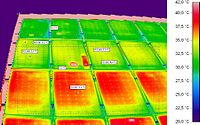Hot spot (photovoltaics)

Think of a hot spot like a really hot potato in a game of hot potato. Just like how the potato gets really hot in one spot, the same thing can happen to a solar panel, which is basically a big potato that transforms sunlight into electricity.
When something blocks some of the sunlight hitting the panel or when there’s a manufacturing flaw, like a scratch or a bump on the surface of the panel, the panel can’t absorb all of the energy from the sun equally. The spot on the panel that’s getting more energy than the rest can heat up and become what’s called a hot spot.
Now, just like how the potato can burn you if you touch the hot spot or area where it’s too hot, the hot spot on a solar panel can cause damage, too. It can make the solar panel less efficient at turning sunlight into electricity and can even cause the panel to degrade faster.
So, just like how you want to get rid of the hot potato before it gets too hot to handle, solar panel technicians try to identify and fix hot spots before they cause any major problems for the panel.
When something blocks some of the sunlight hitting the panel or when there’s a manufacturing flaw, like a scratch or a bump on the surface of the panel, the panel can’t absorb all of the energy from the sun equally. The spot on the panel that’s getting more energy than the rest can heat up and become what’s called a hot spot.
Now, just like how the potato can burn you if you touch the hot spot or area where it’s too hot, the hot spot on a solar panel can cause damage, too. It can make the solar panel less efficient at turning sunlight into electricity and can even cause the panel to degrade faster.
So, just like how you want to get rid of the hot potato before it gets too hot to handle, solar panel technicians try to identify and fix hot spots before they cause any major problems for the panel.
